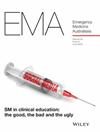The Impact of the COVID-19 Pandemic on Cardiac Related Emergency Department Presentations in Queensland: A Retrospective Cohort Study
Abstract
Objective
To (i) describe and compare rates, demographics, ED characteristics and outcomes for cardiac-related presentations to Queensland EDs before, during and after periods of government restrictions, (ii) determine if and which cardiac conditions were impacted by COVID-19 restrictions.
Methods
Retrospective cohort study of all adult presentations in 105 Queensland public EDs who were diagnosed with a cardiac condition or chest pain. Four periods were compared: ‘pre-pandemic’ (January 2018–March 2020), ‘statewide restrictions’ (11 March–30 June 2020), ‘easing of restrictions’ (1 July 2020–12 December 2021) and ‘outbreak’ (13 December 2021–30 June 2022). ED presentation rates (per 10,000 person-years) and incident rate ratios were calculated for chest pain, ischaemic heart disease, arrhythmias, heart failure, inflammatory conditions, cardiac arrest, and ‘other’ acute cardiac conditions. Proportions of presentations by demographic group, ED characteristics and outcomes were also compared.
Results
The study included 609,485 acute cardiac-related presentations. All-cause acute cardiac presentations decreased by 4% from ‘pre-pandemic’ to ‘statewide restrictions’, then increased by 20% and 25% in the ‘easing of restrictions’ and ‘outbreak’ periods, respectively. Ischaemic heart disease presentation rates decreased during ‘statewide restrictions’. Weekly chest pain presentations dropped early during ‘statewide restrictions’ but increased in each consecutive period. Weekly heart failure presentations appeared to follow seasonal patterns. Compared to ‘statewide restrictions’, inflammatory presentations increased during ‘easing of restrictions’ and ‘outbreak’ periods.
Conclusions
The COVID-19 pandemic impacted acute cardiac-related ED presentations in Queensland in various ways. Public health messaging for people to seek timely medical care for urgent conditions and symptoms should be emphasised in future pandemics.


 求助内容:
求助内容: 应助结果提醒方式:
应助结果提醒方式:


